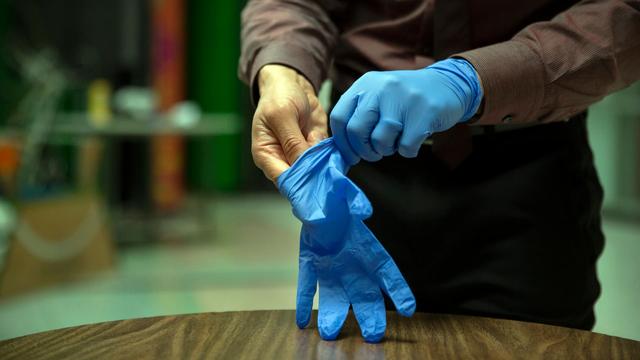The riskiest surfaces for coronavirus and how to clean them
The recent news may have you worried about catching the novel coronavirus by touching the wrong thing.
Playgrounds have been closed across Canada to prevent transmission among children touching the same swings and jungle gyms, which typically aren't sanitized.
And more than a dozen Canada Post employees are in self-isolation after one tested positive for COVID-19. A union local raised concerns about front-linepostal workers transmitting the virus to the publicas demand for parcel delivery skyrockets.
Traces of the virus that causes COVID-19 were also recently discovered on a cruise ship 17 days after infected passengers left.
Here's what you need to know about what materials and surfaces are worse than others, how to clean them, how long the virus lasts and how to protect yourself.
How can viruses be transmitted via surfaces?
COVID-19 is caused by the novel coronavirus known as SARS-CoV-2. Respiratory viruses like it are generally transmitted by droplets sprayed out when an infected person sneezes, coughs or, sometimes, just when they talk.
Those droplets can either land directly on surfaces or be transmitted to surfaces like doorknobs if touched by an infected person, some of whom show no symptoms.
The virus can spread if a person touches a contaminated object or surface and then touches their mouth, eyes or nose with now-contaminated hands.
The technical name for those objects and surfaces is fomites, and this kind of disease transmission is called fomite transmission.
How long can the virus that causes COVID-19 survive on surfaces?
A recent studyby U.S. National Institute of Allergy and Infectious Diseases found that how long the virus can survive depends on the surface. The study found that viable virus could be detected on:
However, the amount of viable virus fell much more quickly than that, and generally, you need to be exposed to a certain "dose" before you can become infected. That said, sometimesonly small amounts of a virus are needed to infect a host.
Also, the study didn't look at how temperature and humidity affect survival time, which has been studied for other viruses.

Another factor that makes a difference to survival time ishow much virus was depositedon the surface in the first place.
You may have read about arecent study that found traces of the virus on surfaces on a cruise ship 17 days after infected passengers left. However, the researchers note those traces were just genetic material — not live virus — and said that doesn't mean the virus was transmitted via those surfaces.
How hardy are coronaviruses on surfaces compared to other viruses?
In general, coronaviruses survive longer on surfaces than cold viruses, but not as long as flu viruses,studies show.
However, experts such as Dr. Isaac Bogoch, an infectious disease specialist and researcher at the Toronto General Hospital, have warned that what has been learned about one coronavirus can't necessarily be applied to other coronaviruses.
In general, respiratory viruses only remain infectious for hours or days on surfaces — not nearly as long as stomach bugs, which can remain infectious for months on surfaces.
How easily are viruses like the novel coronavirus transmitted via surfaces and objects?
We don't know specifically for the coronavirus that causes COVID-19, but studies with other viruses suggest the scale at which it could potentially happen. One study found that three to 1,800 "plaque-forming units" of virus were recovered from the fingers of volunteers who handled faucets or doorknobs contaminated with rhinovirus, a type of cold virus.
Another study that used a virus that does not infect humans found that 65 per cent of the virus could be transferred to uncontaminated hands and 34 per cent could be transferred to the mouth.
What surfaces are riskiest and which ones are safer?
In general, surfaces are riskier if they are:
Also, indoor surfaces are riskier than outdoor, because theUV raysin sunlight can kill viruses.
What can I do to protect myself against this type of transmission?
The Public Health Agency of Canada, U.S. Centers for Disease Control and Prevention and World Health Organization recommend that you:
In public places, you should avoid touching surfaces. If you have to touch something, you can use disinfectant wipes to wipe off surfaces that are touched frequently by other people, such as grocery cart handles, Ottawa epidemiologist Dr. Rama Nair recommends.
WATCH | How to wash your hands effectively:
2 years agoDuration 7:03Using “glo germ,” a product that shows up under black light, Andrew Chang takes a first-hand look at how germs are transmitted, and how to wash them off our hands effectively. 7:03Is wearing gloves a good idea?
The CDC does recommend wearing disposable gloves while cleaning and disposing of them after cleaning.
But remember how coronaviruses were detected on latex gloves? That's clear evidence that gloves become contaminated.
Gloves could give you a false sense of security, could transmit the virus to you if they become contaminated and you touch your face while wearing them. They're also difficult to remove without contaminating yourself, said medical microbiologist Dr. Jocelyn Srigley.
WATCH | Why gloves won't do much to protect you from COVID-19:
2 years agoDuration 1:54Dr. Samir Gupta explains why most people are better off washing their hands with soap and water than wearing gloves for protection against COVID-19. 1:54How can surfaces be cleaned of viruses?
Regular detergents or cleaning solutions can be used to clean items that have even been in contact with an infected person, says the Canadian Centre for Occupational Health and Safety.
The CDC recommends:








